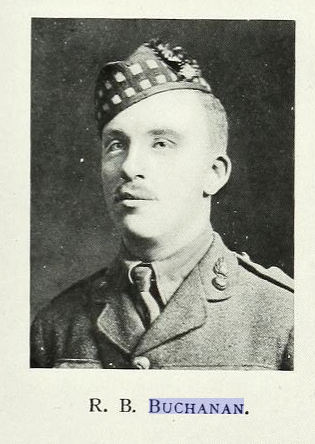My grandfather Charles Richard Buchanan enlisted in the 1st AIF in 1916 and served on the western front in France and Belgium in 1917. He was not at Gallipoli, but there was a Buchanan who fought there – his third cousin, Richard Brendan Buchanan, born in 1894 and so a contemporary of my grandfather. Were they ever aware of one another? They are both mentioned within a couple of pages of each other in the Buchanan Book, published in 1911 in Montreal, but were a continent apart at that time.
Richard Brendan Buchanan was born in Londonderry (Derry city in Co. Londonderry), the second son of Robert Eccles Buchanan and Ethel Maud Williams. Robert, a civil engineer and architect working for the civil service, was the great grandson of Dr George Buchanan of Fintona, Co. Tyrone and was himself born in Fintona.
Richard attended Foyle College in Derry and Bedford School in Bedford, England from 1909 to 1911. He was enrolled as a medical student at the University of Edinburgh, from October 1911 to September 1914. He passed all his exams except the final, with first class honours, being awarded the Bronze medal for Zoology, Practical Anatomy and Surgery.

Photograph of R. B. Buchanan from the University of Edinburgh Roll of Honour 1914 – 1919, published 1921
According to the Diamond War Memorial Project website from Londonderry (http://www.diamondwarmemorial.com/soldiers/view/125):
On the day after the Great War was declared he applied for a commission, and, having some time previously obtained certificates A and B of the Officers’ Training Corps, Medical Unit, was gazetted to a lieutenancy in the Royal Army Medical Corps, Special Reserve, on August 16, 1914. Finding a few weeks later that he could not be sent on active service until he had received his full medical qualifications, he applied for transfer to the Royal Scots Fusiliers, and was in due course gazetted second-lieutenant, and went into training at Cambusbarron, Stirlingshire.
In May 1915, the Royal Scots Fusiliers 1st/5th battalion left Liverpool for the Mediterranean, arriving at Mudros on the island of Lemnos in the Aegean Sea on 29th May. On 7th June they landed at Gallipoli and engaged in various actions against the Turkish Army.
Richard Brendan Buchanan was killed on 20th June 1915 while in a support trench and was buried on a cliff overlooking “Lancashire Landing”, one of the beaches on Cape Helles taken by the Lancashire Fusiliers. His permanent grave is in the Lancashire Landing Cemetery at Gallipoli, grave reference A 31. He was 21.
Richard’s elder brother survived the war. He was Edgar James Bernard Buchanan, two years older, a lieutenant in the Royal Engineers in India and Egypt before returning to England in September 1915. In WW2 he served as Brigadier, Royal Engineers, in the War Office.
And Queen and the Queen? The Queen in question was Queen Victoria. Richard Buchanan’s mother, Ethel Maud Williams, was a daughter of the photographer Thomas Richard Williams, who had a studio in Lambeth and later in Regent St, London. In the 1850s Williams developed a popular business in making high quality stereographic daguerreotypes as a portrait photographer and also made a number of series, including of the Crystal Palace in 1854, and of scenes of English village life. HIs reputation as a portraitist led to commissions from Queen Victoria for photographic portraits of members of the royal household in the mid to late 1850s.
Dr Brian May, guitarist with Queen amongst his other achievements, has an interest in and is a collector of 1850s stereo photographs. In 2009 he and Elena Vidal published the book A Village Lost and Found, including fifty-nine hand-coloured albumen prints on cards made by Williams of scenes in the village of Hinton Waldrist in Oxfordshire, and through their research, revived an interest in this 19th century photographic pioneer. He is also remembered through their website at http://www.londonstereo.com/trwilliams/biography.html.
